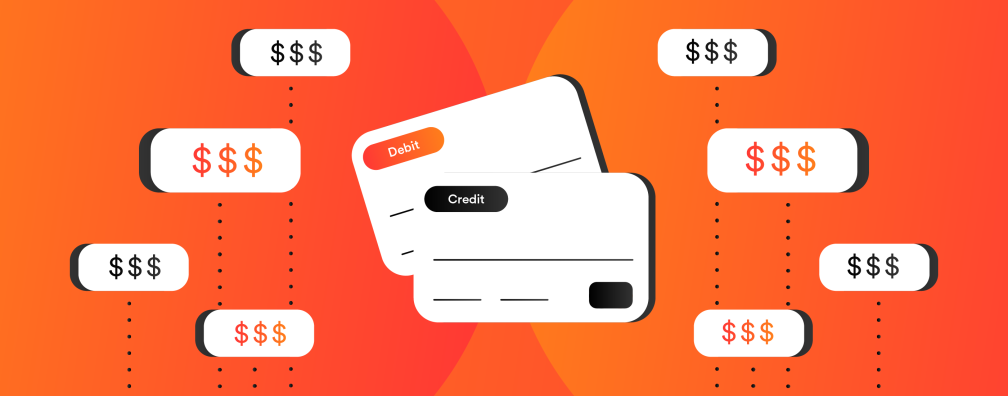Interchange fees explained

What are interchange fees?
Interchange fees are transaction fees that merchants are charged when accepting card payments from customers, whether it's online or in-store payments.
While many think of interchange as a single per-transaction fee, it consists of charges from:
The card issuer: the customer’s bank or credit card company
The card network (e.g. Visa, Mastercard, Discover, American Express)
The acquirer: the merchant’s bank or payment facilitator
Interchange fees are charged based on various factors, such as the type of card the customer uses, the country of card issuance, and whether the transaction happens online or in person.
Let’s examine how interchange works and the processing fees you can expect when you accept debit or credit payments from customers. We’ll also look at the various pricing models that determine interchange fees, and how you can reduce interchange fees for your business.
How interchange works
Let’s take a look at what happens when a customer pays by debit or credit card during an in-store purchase:
The acquirer sends the transaction data to the customer’s card network.
The card network forwards the transaction data to the card issuer.
The card issuer will perform a number of checks (mainly to confirm that the customer has sufficient funds) before telling the card network whether the transaction is approved or declined.
The card network passes this information to the acquirer.
The acquirer processes the transaction.
The card issuer deposits funds into the acquiring account.
Note: Acquirer refers to the acquiring bank that processes card payments for the merchant. It's connected to a card issuing bank by a card network.

The acquirer incurs an interchange fee during this process. Each time a transaction is processed, the acquirer pays a fee to both the card issuer and the card network. The merchant will then have to pay this interchange fee to the acquirer, plus a markup to cover the handling cost.
The bulk of this payment processing fee goes to the card issuer to cover the credit and fraud risks. A portion of the fees also go to the card network. Interchange fees are generally charged as a percentage of the transaction value plus a fixed fee.
How much are interchange fees?
Interchange rates vary based on several factors, which we’ll address in the next section. Generally, you can expect to pay an average rate of 1.3-3.5% of the transaction value, plus a small fixed fee (usually US$0.2 per transaction).
For example, a customer makes a US$150 credit card purchase for a pair of wireless earbuds at a local electronics store. The merchant’s acquiring bank sends the transaction details to the card issuer, which approves or rejects the transaction. After the transaction is approved and processed, the merchant incurs a processing fee for this transaction, which includes the interchange fee. If the interchange rate is 1.5% of the transaction amount, the merchant would pay US$2.25.
From that fee, US$0.30 might go to the acquiring bank, US$0.20 to the credit card network, and US$1.75 to the card issuer. After these deductions, the merchant keeps US$147.75 from the US$150 sale. The customer would typically not notice these charges, as it would be included in the displayed price.
Process payments faster, at low cost
How are interchange fees determined?
The amount charged for each card transaction varies based on several factors:
Card-present (CP) versus card-not-present (CNP)
In-person credit or debit card transactions (card-present) usually have lower interchange fees than transactions that are made online, over the phone, or via mail (card-not-present). This difference is due to the higher risk of card fraud in CNP transactions, prompting card issuers to charge more to mitigate this risk.
Card Present versus Card Not Present transactions
Card Present (CP) refers to a transaction where the cardholder physically presents their payment card to the merchant. In contrast, Card Not Present (CNP) refers to a transaction where the cardholder doesn’t physically present their card. These transactions usually take place online or through other channels such as phone, email, or fax.
CP transactions usually have lower interchange fees than CNP transactions. That’s because CNP transactions generally carry a higher fraud risk, so card issuers may charge higher interchange fees to compensate for this increased risk.
Merchant Category Code (MCC)
Every merchant is assigned a four-digit Merchant Category Code (MCC) that identifies their business type. A merchant’s MCC can affect the interchange fees they pay. For example, card networks usually charge lower interchange fees to charities, compared to airlines that face higher interchange fees as they are deemed a high-risk industry.
Card scheme
Interchange rates differ across card networks. The fee for a transaction made with a Visa card won't be the same as one made with an American Express card. Visa and Mastercard are the two largest card networks that collect the majority of the world’s interchange fees. Other card networks like American Express, Discover, JCB, and UnionPay also collect these fees.
Card type: credit versus debit
Credit card transactions typically incur higher fees than debit card transactions, because credit card issuers use interchange fees to offset the risk associated with offering credit. Debit card payments carry less risk because they draw funds directly from the customer’s bank account.
Credit card companies that offer customers rewards, such as air miles and cashback, may use interchange fees to offset these costs. While reward card payments may come with higher interchange fees than standard card payments, some merchants find paying these fees worthwhile as customers tend to spend more when using reward cards.
Place of card issuance
If a customer’s card was issued in a different country from the merchant’s bank, the interchange fees will be higher to offset the added complexities of cross-border transactions.
Security
Merchants that implement security measures (e.g. network tokenisation and card security codes) to reduce fraud risk are often rewarded with lower interchange fees.
Consumer cards versus commercial cards
Commercial cards (cards issued to businesses) usually have higher interchange fees than cards issued to individuals.
Transaction location
Some regions have introduced legislation to cap interchange fees.
In the European Economic Area (EEA), interchange fees are capped at 0.3% of the transaction amount for consumer credit cards and 0.2% for consumer debit cards. Interregional card transactions have been capped at 1.15% for debit cards and 1.5% for credit cards. There's no cap on commercial cards.
In Australia, interchange fees are capped at 0.8% for credit cards and 0.2% for debit cards.
In the US, interchange rates on credit cards aren't capped and fees average around 2% of the transaction value. But, following The Durbin Amendment in 2010, debit card and prepaid card fees were capped at US$0.22 plus five basis points multiplied by the value of the transaction.
Interchange pricing models
Payment processors use different models to calculate interchange rates. It's important for businesses to understand these models as they directly impact the cost of accepting credit or debit card payments.
Interchange plus pricing (also known as interchange++)
This pricing model is deemed highly transparent: Businesses know exactly how much they're charged because they can see a breakdown of the fees from the card issuer, card network, and acquirer for each transaction. Interchange fees charged for each transaction will vary based on the factors we discussed above.
Tiered pricing
In this model, transactions are categorised into tiers based on risk and reward factors. Different card types are assigned varying interchange rates and fees within these tiers, making it difficult for businesses to predict costs due to fluctuating rates.
Flat-rate pricing (also known as blended pricing)
A fixed rate is charged per transaction, regardless of the card type or transaction method. This fee typically includes a percentage of the transaction value plus a fixed cost. This model simplifies budgeting for businesses as they can predict how much to spend on interchange fees monthly.
While fixed fees mean potential savings on transactions where card network and issuer rates are higher, there could be higher costs for transactions with lower rates. This model aims to provide a fair average rate per transaction, balancing out the overall costs.
Subscription
Under this model, businesses pay a monthly subscription fee in return for lower transaction costs. While the fees charged by the card issuer, card network, and acquirer are similar to the interchange plus model, the markup paid to the acquirer is a flat per-transaction fee.
How interchange fees affect businesses
Interchange fees can impact various aspects of your business, especially if you handle a large volume of card transactions. These areas include:
Operating costs: For businesses with a lot of transactions or with low margins, interchange fees can make up a big part of operating costs and directly affect profitability.
Pricing strategy: To manage the costs associated with interchange fees, businesses may need to modify their pricing. This could involve increasing product or service prices or implementing minimum charges for card payments, which could influence customer satisfaction.
Cash flow: Interchange fees are typically deducted from transactions before the funds are deposited into your business’ bank account. This can affect cash flow management and make financial forecasting more challenging.
Business model: Businesses may encourage customers to use cash or debit cards, which generally incur lower fees than credit cards.
Payment processor: Businesses may decide on payment processors based on the interchange fee pricing models. The availability of payment methods can affect a customer’s decision to purchase.
Besides interchange fees, businesses that operate internationally should be mindful of additional foreign exchange charges for cross-border transactions. Some payment processors charge upwards of 2% per transaction for currency conversion.
How businesses can reduce interchange fees
Here are some tips on how to reduce interchange fees:
Choose the right payment processor: Different payment processors have different pricing models, and choosing one that fits your business can help you save money. It's beneficial for small and medium-sized businesses to compare processors and find a cost-effective option.
Optimise card processing: Card networks may offer lower interchange rates to businesses that follow best practices in card processing. This includes settling transactions promptly, using secure processing technologies like tokenization, and providing detailed transaction data.
Encourage lower-cost payments: Small businesses can consider encouraging customers to use debit cards over credit cards or make cash payments.
Consider surcharges: Adding a surcharge to credit card transactions can help offset interchange fees. But, consider this approach carefully, as it might not be favourable to your customers.
Collect international payments with lower fees
Don’t let interchange fees eat into your profits. Airwallex offers a simple blended pricing model with a transparent fee schedule that lets you forecast the cost of collecting payments easily. Interchange++ pricing is also available for businesses that require it.
Businesses can collect payments locally at lower fees with Airwallex Payment Links and Plugins. These no-code solutions let you customise your payment links and integrate with popular marketplaces such as Shopify, WooCommerce, and Magento. Offer 160+ global payment methods at your checkout, including PayPal, Klarna and WeChat Pay. Accept payments in 130+ currencies while avoiding unnecessary fees from forced conversions.
Revolutionise payment experiences
Share

Regina is a business finance writer at Airwallex. She creates content that simplifies complex financial topics to help businesses make strategic decisions. Leaning on her experience in the eCommerce industry, she offers a unique perspective on how businesses can navigate the payments landscape and the challenges of operating in a global, highly competitive market.
View this article in another region:AustraliaCanada - EnglishCanada - undefinedEurope - EnglishEurope - NederlandsFrance - EnglishFrance - FrançaisNew ZealandSingaporeUnited KingdomUnited States


